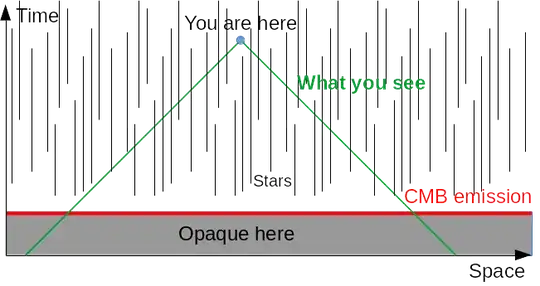It's commonly said that, due the rapid expansion of the universe, it is possible that there are objects (such as stars) that could be beyond our field of vision, given the finite speed of light. Since it is possible that space is expanding faster than the speed of light, that makes sense. But, if we can see microwave background radiation (MBR) in whatever direction we look and if MBR is from an era prior to the creation of stars, when we see the MBR, we are seeing something that existed before the creation of stars. We are seeing something that is older and further than stars. If can see IT, then must we not we be seeing all the stars which came after it because they would be younger and closer?
6 Answers
The diagram should clarify. It is qualitative, and uses space and time coordinates chosen so that light rays are diagonal for simplicity. Thus it does not directly show the expansion of the universe.
The green line is our past light cone. Note that what we see in the sky is what's on it (not inside it). Of course, space is 3D (rather than 1D), so we can see beyond stars by looking between them, but the CMB was emitted everywhere, so we cannot see anything beyond that.
The diagram shows that there are stars we cannot see because they are too far away for their light to reach us yet.
- 4,058
- 11
- 15
First, see Did the Big Bang happen at a point?. As it explains, the Big Bang did not happen at a point. It happened everywhere at once.
Microwave background radiation was the blackbody radiation the very hot universe emitted when it cooled enough to be transparent. It was emitted everywhere, just like matter that later became stars was everywhere. Since then, the universe has expanded and the wavelength has stretched into the microwave region.
Just as there are stars so distant their light has not reached us, there is microwave background radiation from regions so distant that it hasn't reached us yet either.
- 49,702
The salient facts are that the CMB was emitted almost isotropically from everywhere in the universe. The CMB we see today has travelled from regions that are currently 45 billion light years away (thanks to the universal expansion). The CMB we saw yesterday came from regions that were nearer than the CMB we will see tomorrow.
Stars were born after the CMB was formed and we think that happened homogeneously across the entire universe. The oldest stars we can see are in our own Galaxy, and are about 13 billion years old. As we look into the distant universe we see other examples of those stars in distant galaxies, as they were in the past. When we look far away to regions that are approaching the current 45 billion light year distance of the CMB, we get the chance to witness the birth of those very old Galactic stars, but in another place.
However, there will be stars beyond those. We will be able to observe them in the future. At that future time, the CMB will still be coming from regions that are further away than where we see the stars.
- 141,325
The reason for the confusion that drives the question is the Andromeda paradox (https://en.wikipedia.org/wiki/Rietdijk–Putnam_argument): that is, as David Mermin puts it in It’s About Time (Princeton University Press, Princeton, 2005):
"That no inherent meaning can be assigned to the simultaneity of distant events is the single most important lesson to be learned from relativity."
What that means is the CMB we will detect tomorrow, hasn't necessarily happened yet..it truly is reference frame dependent. There are frames here, now, in which its emission is still in the future.
In a reference frame that is (locally) stationary with respect to the CMB or Hubble Flow, it happened 13.79... billion years ago, and the gas has since gone on to form galaxies and stars, now, which we may or may not see, depending on the Cosmic Event Horizon.
- 42,131
There are many objects to far away to see including galaxies. The answer to your question is hinted in your question. The cosmic microwave background is much much older than the stars and has been heading our direction a lot longer than the light from the stars has. Even at the time our sun was born we were already getting a look at the distant past from the CMB.
- 4,159
You can in fact, see all the stars that came into being after the "creation" of the CMBR. That is, all the stars that not lie behind the horizon of the visible universe. The CMBR that we see today came into being before the birth of the most distant stars we are able to see.
Then why isn't the wavelength of the CMBR stretched to infinity, like the wavelength of the radiation coming from stars on the horizon? Because the CMBR originated on a spherical surface, wrt to us, that lies in front of the horizon surface. All visible stars lie in front of that horizon too. Wrt to us.
The CMBR originated throughout the universe. Observers far beyond the horizon will see the same CMBR. Well, not the same in the sense that they receive the same photons, but the form of the CMBR is the same, i.e., if you assume the CMBR to be the same throughout the whole universe.
Stars can of course be present behind the horizon. For people far beyond the horizon, there is the same spherical surface from which the CMBR originated. For them too, this surface is situated in front of their horizon surface.
- 1
- 5
- 45
- 105
